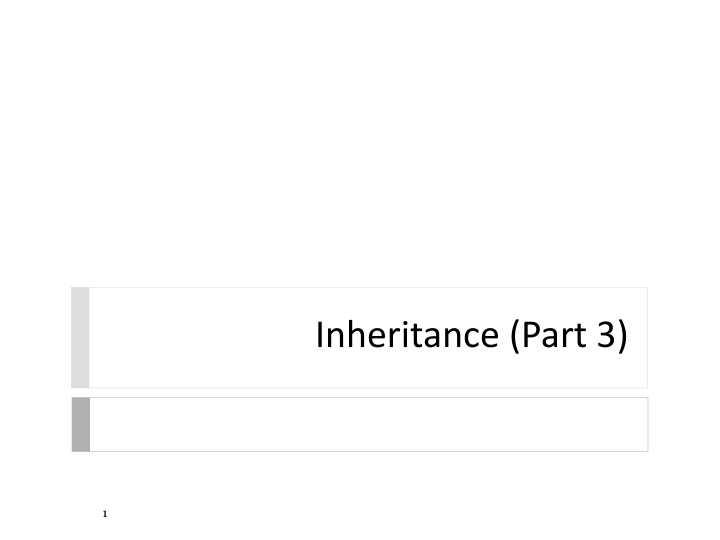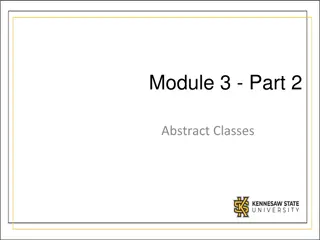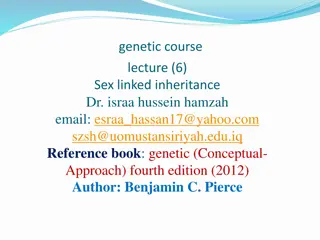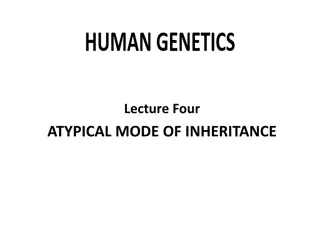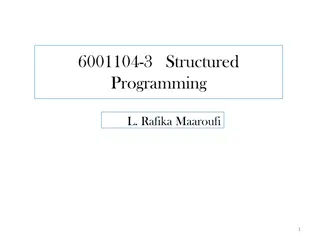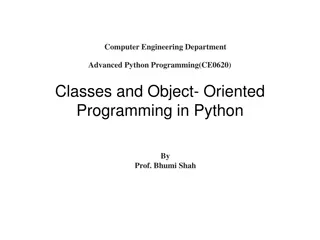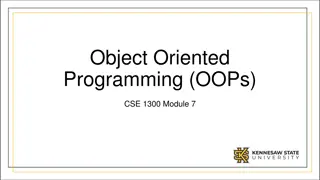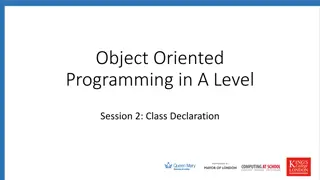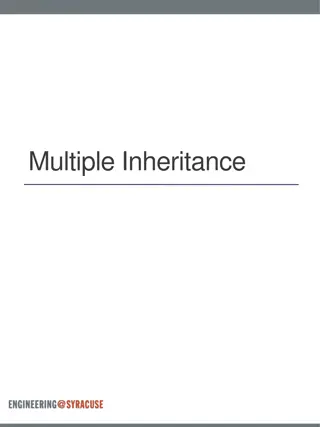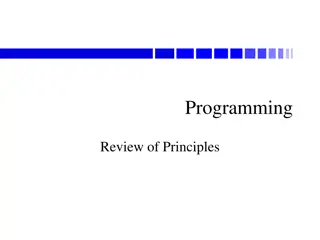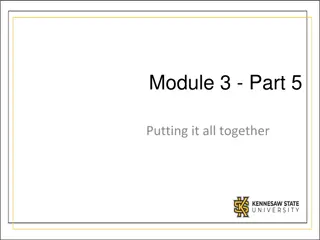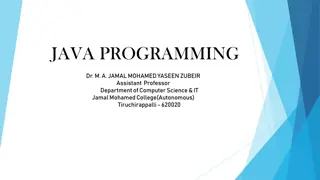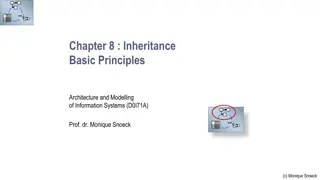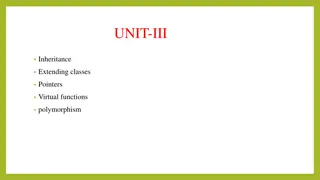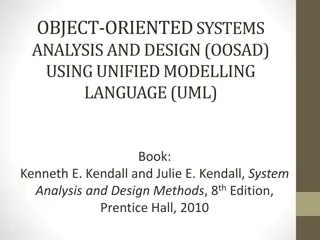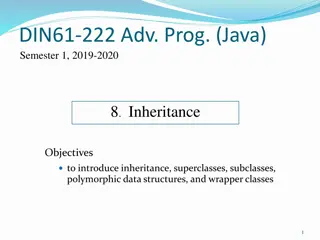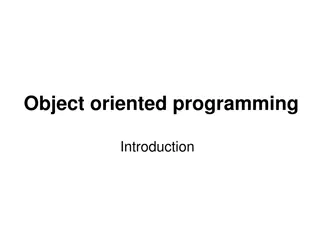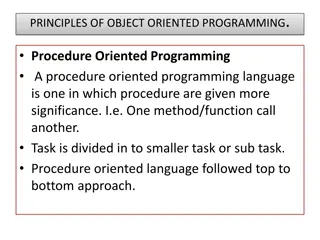Inheritance in Object-Oriented Programming
Inheritance in OOP allows subclasses to inherit behaviors from superclasses. Learn about preconditions, postconditions, and how they interact with inheritance, ensuring proper method assumptions and promises.
Uploaded on Mar 04, 2025 | 0 Views
Download Presentation

Please find below an Image/Link to download the presentation.
The content on the website is provided AS IS for your information and personal use only. It may not be sold, licensed, or shared on other websites without obtaining consent from the author.If you encounter any issues during the download, it is possible that the publisher has removed the file from their server.
You are allowed to download the files provided on this website for personal or commercial use, subject to the condition that they are used lawfully. All files are the property of their respective owners.
The content on the website is provided AS IS for your information and personal use only. It may not be sold, licensed, or shared on other websites without obtaining consent from the author.
E N D
Presentation Transcript
Preconditions and Inheritance precondition what the method assumes to be true about the arguments passed to it inheritance (is-a) a subclass is supposed to be able to do everything its superclasses can do how do they interact? 2
Strength of a Precondition to strengthen a precondition means to make the precondition more restrictive // Dog setEnergy // 1. no precondition // 2. 1 <= energy // 3. 1 <= energy <= 10 // 4. energy == 5 public void setEnergy(int energy) { ... } weakest precondition strongest precondition 3
Preconditions on Overridden Methods a subclass can change a precondition on a method but it must not strengthen the precondition a subclass that strengthens a precondition is saying that it cannot do everything its superclass can do // Dog setEnergy // assume non-final // @pre. none // Mix setEnergy // bad : strengthen precond. // @pre. 1 <= nrg <= 10 public void setEnergy(int nrg) { // ... } public void setEnergy(int nrg) { if (nrg < 1 || nrg > 10) { // throws exception } // ... } 4
client code written for Dogs now fails when given a Mix // client code that sets a Dog's energy to zero public void walk(Dog d) { d.setEnergy(0); } remember: a subclass must be able to do everything its ancestor classes can do; otherwise, clients will be (unpleasantly) surprised 5
Postconditions and Inheritance postcondition what the method promises to be true when it returns the method might promise something about its return value "returns size where size is between 1 and 10 inclusive" the method might promise something about the state of the object used to call the method "sets the size of the dog to the specified size" the method might promise something about one of its parameters how do postconditions and inheritance interact? 6
Strength of a Postcondition to strengthen a postcondition means to make the postcondition more restrictive // Dog getSize // 1. no postcondition // 2. return value >= 1 // 3. return value // between 1 and 10 // 4. return 5 public int getSize() { ... } weakest postcondition strongest postcondition 7
Postconditions on Overridden Methods a subclass can change a postcondition on a method but it must not weaken the postcondition a subclass that weakens a postcondition is saying that it cannot do everything its superclass can do // Dog getSize // // @post. 1 <= size <= 10 // Dogzilla getSize // bad : weaken postcond. // @post. 1 <= size public int getSize() { // ... } public int getSize() { // ... } Dogzilla: a made-up breed of dog that has no upper limit on its size 8
client code written for Dogs can now fail when given a Dogzilla // client code that assumes Dog size <= 10 public String sizeToString(Dog d) { int sz = d.getSize(); String result = ""; if (sz < 4) result = "small"; else if (sz < 7) result = "medium"; else if (sz <= 10) result = "large"; return result; } remember: a subclass must be able to do everything its ancestor classes can do; otherwise, clients will be (unpleasantly) surprised 9
Exceptions all exceptions are objects that are subclasses of java.lang.Throwable Throwable Exception RuntimeException ... ... and many, many more ... ... IllegalArgumentException and many more 10 AJ chapter 9
User Defined Exceptions you can define your own exception hierarchy often, you will subclass Exception Exception public class DogException extends Exception DogException BadSizeException NoFoodException BadDogException 11
Exceptions and Inheritance a method that claims to throw a checked exception of type X is allowed to throw any checked exception type that is a subclass of X this makes sense because exceptions are objects and subclass objects are substitutable for ancestor classes // in Dog public void someDogMethod() throws DogException { // can throw a DogException, BadSizeException, // NoFoodException, or BadDogException } 12
a method that overrides a superclass method that claims to throw a checked exception of type X can also claim to throw a checked exception of type X or a subclass of X remember: a subclass is substitutable for the parent type // in Mix @Override public void someDogMethod() throws DogException { // ... } 13
Which are Legal? in Mix @Override public void someDogMethod() throws BadDogException @Override public void someDogMethod() throws Exception @Override public void someDogMethod() @Override public void someDogMethod() throws DogException, IllegalArgumentException 14
Review Inheritance models the ______ relationship between classes. Dog is a ______ of Object. Dog is a ______ of Mix. Can a Dog instance do everything a Mix instance can? Can a Mix instance do everything a Dog instance can? Is a Dog instance substitutable for a Mix instance? Is a Mix instance substitutable for a Dog instance? 1. 2. 3. 4. 5. 6. 7. 15
Can a subclass use the private fields of its superclass? Can a subclass use the private methods of its superclass? 8. 9. 10. Suppose you have a class X that you do not want anyone to extend. How do you enforce this? 11. Suppose you have an immutable class X. Someone extends X to make it mutable. Is this legal? 12. What do you need to do to enforce immutability? 16
13. Suppose you have a class Y that extends X. Does each Y instance have a X instance inside of it? How do you construct the X subobject inside of the Y instance? What syntax is used to call the superclass constructor? What is constructed first the X subobject or the Y object? Suppose Y introduces a brand new method that needs to call a public method in X named xMethod. How does the new Y method call xMethod? Suppose Y overrides a public method in X named xMethod. How does the overriding Y method call xMethod? a. b. c. d. e. f. 17
14. Suppose you have a class Y that extends X. X has a method with the following precondition: @pre. value must be a multiple of 2 If Y overrides the method which of the following are acceptable preconditions for the overriding method: @pre. value must be a multiple of 2 @pre. value must be odd @pre. value must be a multiple of 2 and must be less than 100 @pre. value must be a multiple of 10 @pre. none a. b. c. d. e. 18
14. Suppose you have a class Y that extends X. X has a method with the following postcondition: @return A String of length 10 If Y overrides the method which of the following are acceptable postconditions for the overriding method: @return A String of length 9 or 10 @return The String "weimaraner" @return An int @return The same String returned by toString @return A random String of length 10 a. b. c. d. e. 19
15. Suppose Dog toString has the following Javadoc: /* * Returns a string representation of a dog. * The string is the size of the dog followed by a * a space followed by the energy. * @return The string representation of the dog. */ Does this affect subclasses of Dog? 20
Inheritance Recap inheritance allows you to create subclasses that are substitutable for their ancestors inheritance interacts with preconditions, postconditions, and exception throwing subclasses inherit all non-private features can add new features can change the behaviour of non-final methods by overriding the parent method contain an instance of the superclass subclasses must construct the instance via a superclass constructor 21
